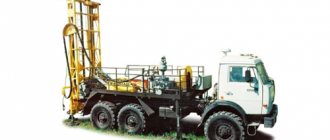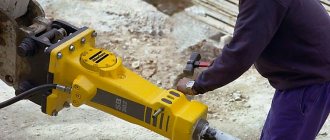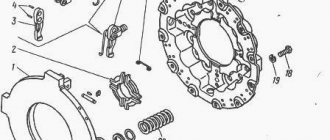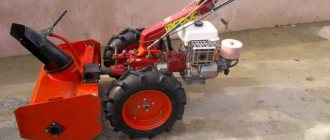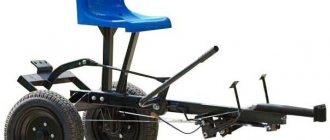Rotary drilling ↑
The rotary method is one of the most common. The operating principle of the installation is the transmission of rotational motion to the drill string via a rotor. Drilling is accompanied by flushing or blowing (more often and simply - flushing) to remove destroyed rock from the bottom. Water or clay solution is used as a flushing agent. The method loses its effectiveness or economic feasibility in areas with a shortage of water and clay.
The lifting equipment that raises and lowers the drill string is mounted on the tower, like other elements of the rig. An internal combustion engine is used as a motor - sustainer or deck (separate or from the car). The drive transmits rotation from the engine to the rotor. The rotor converts the rotation of the shaft into rotation of the rotary table. The kelly pipe of the drill string is fixed in the table. Along the drill string, rotation is applied to the bit. The working edges of the bit destroy the rock.
The drill string receives only rotation from the rotor and retains freedom of axial movement to maintain an extended position (to avoid bending of the barrel). To ensure proper pressure on the bit, weight pipes are present in the drill string - they create a force over the bit, while simultaneously maintaining the string in an extended position.
The flushing composition flows through the hollow pipes of the column to the bit nozzles. The liquid is supplied under pressure, it erodes the soil and brings it to the surface through the annulus (the gap between the column and the shaft). The composition enters a special pit, where it is cleaned, and then the pump pumps it back into the column.
The choice of flushing composition and bit material depends on the rock being penetrated. Clay solution is used in loose rocks, and clean water is used in rocky rocks. An alternative is blowing, but it requires a tank of compressed air.
Rotary drilling is a high-speed method, it is suitable for almost all rocks. This is “almost” insidious: everything can be ruined by a banal boulder, brazenly located underground, and the walls of the trunk, actively absorbing the flushing solution. In winter there are also difficulties - the liquid freezes.
Small-sized installation for rotary drilling ↑
Regardless of the base (autonomous equipment or transport-based), size, weight, the installation consists of:
- towers,
- engine,
- drive,
- rotor,
- drill string,
- swivel,
- pressure line,
- pump,
- liquid return systems after cleaning,
- lifting equipment.
Rotor installation diagram
Device
The drill is equipped with a set of replaceable drills for different types of soil and drilling methods. Also includes equipment for soil washing. This can be either its own pump for flushing liquid, or the ability to connect to an external source.
The photo shows a hydraulic drilling rig
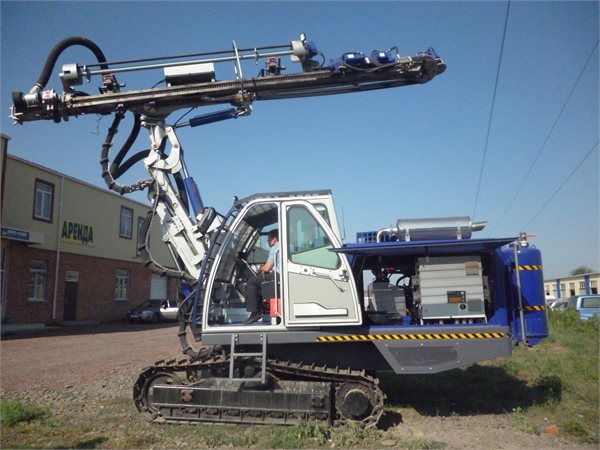
The diesel internal combustion engine is connected to an oil pump, which provides pressure to operate the hydraulics. This includes rotation of the drill, its movement along the mast, as well as changes in the position of the mast itself.
The mast is attached to the main frame and supported hydraulically. It is possible to install the frame in the back of a pickup truck, or on a self-propelled tracked unit. Such self-propelled hydraulic drilling rigs are, of course, also commercially available. By placing the diesel engine and oil pump at the rear of the frame, they also act as a counterweight for the mast and rig. This way the weight is distributed evenly and the center of gravity is in the center. When changing the angle of the mast, it also does not move much.
Shock-rope method ↑
The advantages of shock-rope installations are considered to be long service life, wear resistance and simplicity. If simplicity still passes for a virtue, then wear resistance and service life have no meaning for an individual citizen who wants to drill a well on his site with his own hands. He needs this installation for one time, and then let it go to dust. The simplicity of the design has its place, but not without sacrifices, and time was sacrificed - you can pick the ground with a drill glass all summer. The method and equipment are suitable for those who have a lot of strength, but no work. But a small-sized installation can be done with your own hands, without having special skills or engineering education.
The installation for drilling using the percussion-rope method consists of:
- tripods,
- block,
- drilling tool (glass/bailer),
- winches,
- cable
Small-sized installation for percussion-rope drilling ↑
To make a small-sized installation for percussion-rope drilling, you need to acquire a welding machine, a drilling rig, a block, a winch (optional), a cable, pipes: 3 for the frame (triangle on the ground), 3 for the legs. First, a triangle is welded, then pipes are welded to it, connected into a pyramid without a base. The block is mounted at the top (under the junction of the tripod pipes). A rope is attached to the glass/bailer and thrown over the block. Next, everyone chooses for themselves: to work exclusively with their hands or to entrust the honor of lifting the glass to the winch.
The principle of operation is amazingly simple: the drill bit is lowered into the barrel under its own weight and filled with soil (cuts the rock with sharp edges); it is removed to the surface, released and lowered back into the barrel. That's how they drill. In loose soils that do not want to linger in the glass, a bailer is used - it closes as it is filled, and the rock does not spill out. The signal to use the bailer is to raise the empty glass several times in a row.
The design can be made not triangular, but rectangular, that is, not three legs, but four. It can only be considered small-sized only conditionally - it will require a decent height.
It must be taken into account that on the way there are not only frogs and moles, but also treacherous aquifers, forcing you to interrupt the already tedious drilling process and install a casing pipe. In addition, each rock can be “taken” with a drill glass; rocky ones are destroyed with a chisel. Having stumbled upon rocks, you will have to drill in another place, and how many times this will happen is unknown in advance (they drill with their own hands when they are saving money, and they save money primarily on geological research). This is where the working resource of the installation comes in handy (we shouldn’t waste it and return it to advantage). Jokes aside, the method has existed since ancient times, and it is not abandoned - very high-quality wells are obtained. However, despite its simplicity, we do not recommend doing it yourself - the time and physical costs are too great.
Screw method ↑
The screw method is a rotary method. They use a drill of a special design - destroying the rock, it feeds it to the surface along spiral blades.
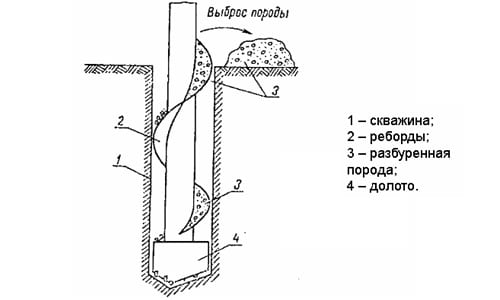
Scheme of operation of an auger drill

Installation diagram
In the process of drilling on the simplest rigs, the drill is increased as it goes deeper.
The drilling rig is equipped with a rotation mechanism. We do not recommend performing the exercise with manual rotation of the drill - it would be better then with a glass.
For independent citizens, there are difficulties - choosing the right drill (depending on the breed).
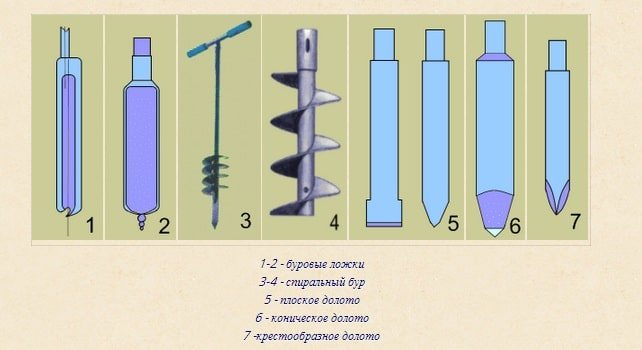
Auger drills
Video: drilling a well with a small-sized drilling rig ↑
Drilling rigs with hydraulic rotator
Drilling rig URB-4MG
Used for drilling various surfaces with rock strength not exceeding category 10. Equipped with a 30 HP engine. pp., which allows drilling at speeds of up to 25 m/h when working with sand, 20 m/h when passing through a layer of clay and up to 3 m/h when drilling hard rocks.
It is used in geotechnical work for drilling wells, analyzing soil for foundation construction, monitoring groundwater and other work performed in conditions of insufficient space.
Specifications:
| Installation power, l. With. | 30 |
| Rock strength category | to 10 |
| Maximum initial bit diameter, mm | 350 |
| Drilling depth, m/h: | |
| with flushing | up to 100 |
| auger | up to 30 |
| Average drilling speed (m/h): | |
| sand | 25 |
| clay | 20 |
| clay with layers of hard rock | 5 |
| hard and strong rocks | until 3 |
| Maximum torque, Nm | up to 560 |
| Rotator speed, rpm. | up to 150 |
| Lifting effort, kg | 2500 |
| Downward feed force, kg | 2500 |
| Stroke of the rotator carriage, mm | 1680 |
| ICE PRO 15HP, pcs. | 2 |
| Weight, kg | up to 700 |
| Cost, rub. | 260 000 |
Drills and rods are not included in the installation price and must be ordered separately.
Drilling rig UB-250-G
Used in geological work for drilling wells at an angle of 50-90 degrees relative to the horizon. It can be equipped with 3 types of engines - diesel, developing a power of 21 hp. s., petrol, power 16.5 l. With. and an electric motor with 18.5 liters. With. In addition to power, other technical characteristics of these models differ.
The UB-250-G installation is used in construction work and has proven itself due to its excellent performance characteristics, reliability and durability. Ease of control, low energy consumption and maintainability are also advantages of this drilling rig.
Specifications:
Pumping station—unit drive ICE diesel ICE gasoline Electric motor—model Lombardini 9LD 625/2Honda GX-6905AMX160M2U3 18.5*3000 IM2081—engine power, kW 2116.518.5—hydraulic pumpGP2-0140+ GP1-0034+GP1-0027GP2-0140+ GP1-0027 — working pressure, MPa21; 20; 2018; 1821;21High-torque rotator—rotator drive from two hydraulic motorsMS-80MS-100210.12.01MS-80MS-100MS-80MS-100parallel connection of hydraulic motors—maximum torque, kgf m8210414789776110—spindle rotation speed, rpm 0…990…790…6900 …900…720…1050…90 series connection of hydraulic motors—maximum torque, kgf m41523948.53855—maximum spindle speed, rpm.Small-sized drilling rigs ↑
Small-sized drilling rig - “what’s in my name?” If you imagine a tripod with a small glass for independent attempts to turn the area into a colander, the association is completely wrong. Of course, there are tripods, including for percussion-rope drilling, but besides them, in the vast expanses of villages, “babies” on tracked chassis, based on a tractor and trailer, and autonomous (mobile, lightweight) are successfully working.
Autonomous block installation ↑

Stand-alone block installation
A small-sized block installation, equipped with a 15-horsepower engine (or winches) and a hydraulic drive (750 or 1500 Hm), is capable of drilling a well to a depth of 50–150 m (blowing/flushing). The unit is easy to transport/carry. It is transported in a regular car trailer.
There are different installations - for percussion-rope, rotary, auger drilling. The equipment is widely used in drilling sand wells and Abyssinian wells.
Based on a trailer ↑
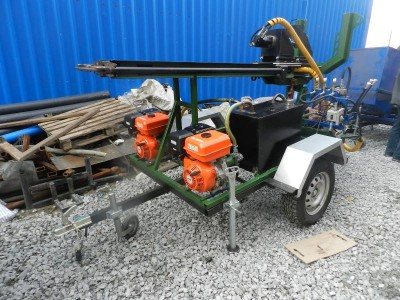
Car trailer
The installation, developed on the basis of a car trailer, is powered by a 50-horsepower (or 60 hp, depending on the configuration) diesel engine. The engine can be air or liquid cooled. In addition to water intake wells, exploration wells are drilled with such installations. The equipment is used in various construction and geological works.
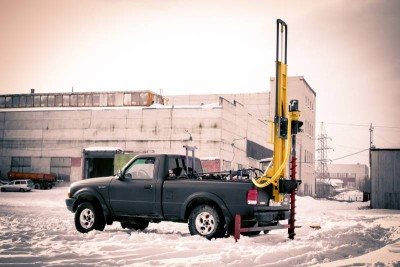
Car based modification
On a tracked chassis ↑
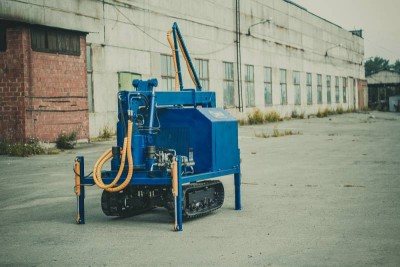
Track mounted installation
The installation on a crawler chassis is equipped with a diesel engine and hydraulic drive. In addition to drilling wells, the equipment is used in the construction of pile foundations (specifically for mechanized installation of piles) on insufficiently strong soils. The crawler track provides maneuverability to the unit and allows it to work in places where equipment on a conventional wheelbase simply cannot pass (especially heavy ones).
Based on a tractor ↑
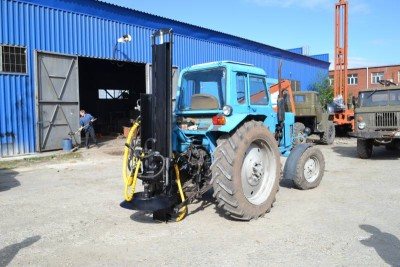
Tractor-based installation
The tractor-based installation is highly specialized; it is suitable for rotary drilling of wells with a depth of no more than 3 m. The equipment is used in areas where soil conditions leave much to be desired. The installation is equipped with a hydraulic drive. Working tool - auger or drill.
To develop one well, purchasing a mechanized small-sized drilling rig does not make sense (it will be more expensive than a turnkey well from specialists). Equipment can be rented (it’s not difficult to find leasing, but for this form of cooperation you need to be at least an individual entrepreneur), but in any case you need to be able to handle it. What are the advantages for the average consumer of services (not counting those who will cook tripods)? The fact is that the “babies” work great in hard-to-reach places, plus the site will not be destroyed by heavy equipment. The well will be drilled where it is needed, and not where it will work out.
We offer the service of auger drilling of wells using drilling rigs
Buy Larsen sheet pile Leader drilling Rental of a KamAZ-based pit drill Drilling for sheet piles
You can order auger drilling of wells from our company. We carry out drilling work in Moscow and the Moscow region .
The variety of well drilling technologies makes it possible to accurately select the required method, which will be the optimal solution in terms of the quality of penetration, the time and materials spent, and, accordingly, the cost. Auger drilling is used if there is a need to drill a well in soft and loose rocks, where it will be ideal in all respects.
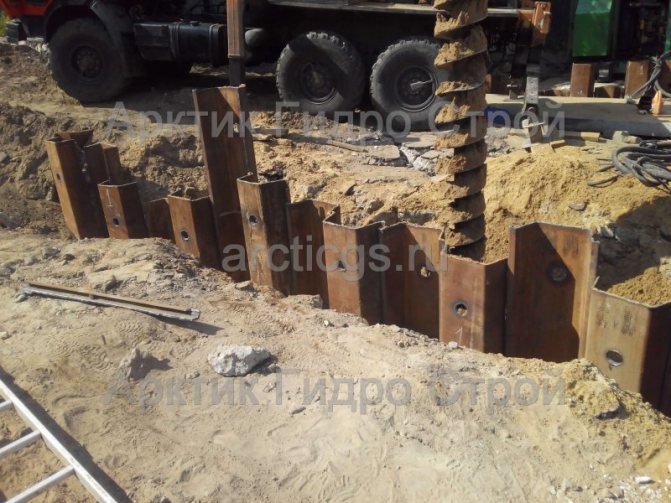
In this case, a well can only be drilled to a depth of 50 m, less often to 80 m with a diameter of 60-800 mm. Auger drilling technology is mainly used to form wells for blasting operations when the task is to carry out geological exploration or engineering surveys during exploration of certain types of minerals.
You can order auger drilling from our company
Prices for zero cycle work and equipment transfer are the lowest in the region.
For any questions call: 8 800 707-72-09
